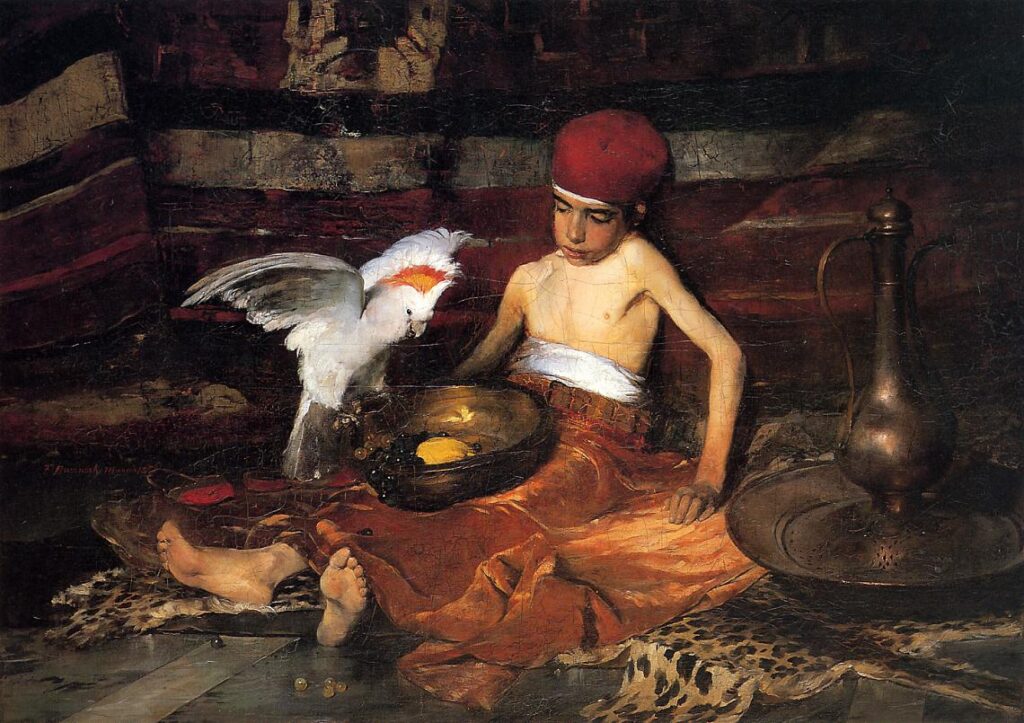Reading Visual Art: 210 Parrot B

Parrots, parakeets, cockatoos and the humble budgerigar (a small parakeet) have long been popular domestic pets in Europe, and are featured in many paintings. In this second look at a selection of paintings including these birds, I start with still lifes from the Dutch Golden Age.
Pieter Boel (–1674), Still Life with a Globe and a Parrot (c 1658), oil on canvas, 313 x 168 cm, Akademie der bildenden Künste Wien, Austria. Wikimedia Commons.
From the days of the Northern Renaissance, artists in the Low Countries had pursued the accurate depiction of optical effects in their paintings. Pieter Boel’s Still Life with a Globe and a Parrot from about 1658 continues that tradition, with its outstanding three-dimensional effects in the plate and goblet in the foreground.
The globe shows the Pacific Ocean and the north-west coast of America, with the ‘Dutch’ East Indies at its left edge. The bas-relief plate shows a scene from mythology, in which male and female deities are riding in a chariot. The two porcelain bowls at the far right appear Chinese, and there’s a white parrot or cockatoo, together with a small dog at the bottom left corner.
Jakob Bogdani (1658–1724), Capuchin squirrel monkey, two guinea pigs, a blue tit and an Amazon Saint Vincent parrot with Peaches, Figs and Pears in a landscape (c 1710-20), oil on canvas, 54.7 x 107 cm, location not known. Wikimedia Commons.
After Hungaro-British painter Jakob Bogdani (1658–1724) moved to London via Amsterdam in 1688, he painted several works featuring animals and birds. Those included Capuchin squirrel monkey, two guinea pigs, a blue tit and an Amazon Saint Vincent parrot with Peaches, Figs and Pears in a landscape towards the end of his career, in 1710-20.
Johann Amandus Winck (1748–1817), Still life with a Parrot, Game Fowl, Guinea Pigs and Fruit (date not known), oil on copper, 20.9 x 27.3 cm, location not known. Wikimedia Commons.
Johann Amandus Winck’s Still life with a Parrot, Game Fowl, Guinea Pigs and Fruit must have been painted in the late eighteenth century.
Parrots also appear in some more curious contexts.
Agostino Carracci (1557–1602), Hairy Harry, Mad Peter and Tiny Amon (1598-1600), oil on canvas, 101 x 133 cm, Museo di Capodimonte, Naples, Italy. Wikimedia Commons.
Painters have long been attracted to the spectacle of humans who look different. In Agostino Carracci’s case, he combined three strange examples in his Hairy Harry, Mad Peter and Tiny Amon, completed between 1598-1600, not long before his death. From the left are Tiny Amon (Rodomonte) the dwarf, Arrigo Gonzalez the hirsute (Hairy Harry) from the Canary Islands, and Mad Peter (Pietro the buffoon). Accompanying them are a large parrot, a couple of dogs, and two monkeys.
Since then, parrots and their relatives have continued to appear sporadically in paintings.
Frank Duveneck (1848–1919), The Turkish Page (1876), oil on canvas, 106.7 × 148 cm, Pennsylvania Academy of the Fine Arts, Philadelphia, PA. Wikimedia Commons.
In 1876, Frank Duveneck and William Merritt Chase painted a young boy carefully posed with a parrot, in Chase’s Munich studio. Duveneck’s The Turkish Page, above, is technically brilliant, and an ambitious work for someone within seven years of starting their training. It was exhibited at the National Academy of Design in New York the following year, but had a mixed response. Viewers found its still life approach lost narrative, and were puzzled by the depiction of the child. By the time it was displayed at the Pennsylvania Academy in its 1893-4 exhibition, changing taste brought it acclaim, and it sold.
Chase’s version, below, was surprisingly different in many respects. I leave it to you to decide which you prefer, although I think the parrot seems happy with both.
William Merritt Chase (1849–1916), The Turkish Page (Unexpected Intrusion) (1876), oil on canvas, 104.8 × 94.5 cm, Cincinnati Art Museum, Cincinnati, OH. Wikimedia Commons.
Henry Tonks (1862-1937), Summer (1908), oil on canvas, 94 x 94 cm, The Tate Gallery (Presented by Mrs F.J. Weldon 1931), London. © The Tate Gallery and Photographic Rights © Tate (2016), CC-BY-NC-ND 3.0 (Unported), http://www.tate.org.uk/art/artworks/tonks-summer-n04565
Henry Tonks’ Summer (1908) is a dazzlingly rich and intricate view of the garden at Arfleet, near Corfe Castle, Dorset, England. Using a real mother and her son as models, the boy’s rocking horse and a cockatoo are unusual objects to see in an English garden in summer.
Frances Hodgkins (1869–1947), Wings over Water (1930), oil on canvas, 71.1 x 91.4 cm, The Tate Gallery (Presented by Geoffrey, Peter and Richard Gorer in memory of Rèe Alice Gorer 1954), London. © The Tate Gallery and Photographic Rights © Tate (2016), CC-BY-NC-ND 3.0 (Unported), https://www.tate.org.uk/art/artworks/hodgkins-wings-over-water-n06237
The expatriate New Zealand artist Frances Hodgkins painted Wings over Water during the winter of 1931-32. It shows a view from her rooms in Bodinnick, Cornwall. Carefully placed in the foreground is a still life consisting of three large seashells with floral and plant arrangements. Sitting on the fence in the middle of the view is her landlady’s parrot, beyond which is the expanse of the nearby River Fowey.
Pierre Bonnard (1867-1947), Woman with Parrot (1910), oil on canvas, 104 x 122 cm, Private collection. The Athenaeum.
Finally, for Pierre Bonnard parrots came by chance. His Woman with Parrot is set in le Midi in 1910, with intensely bright and hot colours, against which the large blue parrot, some pots, and foliage make contrast. This was painted in Saint Tropez during Bonnard’s visit in September that year, and was based on an experience that the artist wrote about in a letter to his mother, in which he had passed a young dark-haired girl with an enormous blue parrot. As you do.




